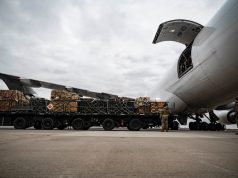Ukrainian air defenses have been able to intercept all Kalibr cruise missiles launched by Russia in the aftermath of the attack on the Crimean bridge, a Pentagon official has said.
Speaking to reporters on October 14, the senior military official said that an estimated three Kalibr-capable Russian Navy ships fired the missiles from the sea, “and our understanding is that they were all intercepted by the Ukrainian air defenses.”
The 3M-54 Kalibr employed by Russian Navy ships is a multi-purpose cruise missile that carries high explosive or thermonuclear warheads ranging from 400 to 500 kilograms. It first saw operational use in 2015 when Russian Navy ships launched it at ISIS positions in Syria.
To remind, Russia launched large-scale missile attacks on non-military infrastructure in Ukraine following an attack on the bridge connecting Russia with Crimea on October 8. That attack, now widely believed to have been a truck bomb, resulted in multiple spans of the road section collapsing and left the freight section in flames.
Reflecting on Russia’s response to the attack, the official said Russia continued to use “precision-guided munitions in a very imprecise way,” “in violation of what the international rules of war stand for.”
The official estimated the number of Russian missiles launched to be in the hundreds, “and in many — in most, I would tell you, cases, they have been used at civilian targets either indiscriminately or certainly in a deliberate way, as it relates to infrastructure targets like electricity or bridges or otherwise,” the official said.
Reflecting on the situation in other regions of Ukraine, the official said Ukraine achieved limited gains in Kharkiv over the course of the week.
“We have seen the Russians continue to strengthen their defenses in the Kharkiv area, and so it’s at a stop, is probably the wrong term. There are some very minor incremental gains, really, all the way from the northern portion of the Kharkiv area of operation down towards Lyman, but really limited in terms of movement this week,” he said.
“In Bakhmut it’s similar, but the other way. So we’ve seen — so now moving down to — the center portion of the eastern front there around Bakhmut, we’ve seen the Russians continue to work to attack the Ukrainians around Bakhmut. Those gains have also been very small for the Russians, and in times we’ve seen the Ukrainians counterattack with effectiveness to retake land that the Russians had previously taken. All of those attacks on both sides are coming with pretty high impact in terms of the employment of artillery and the losses to the sides who are making those advances.”
“And then in Kherson, probably more movement in Kherson than anywhere else on the battlespace. And so Kherson, if you describe it, has three different axes in the Kherson area of operation: the north, the central and the south. We’ve seen them continue to advance in the north, and so we have seen gains in the north now. Really, the line of advance for the Ukrainians just north of the city of Milove, or Milove, — however you’d like to pronounce it, all of them probably incorrect.”
“And then extending, essentially, to the north and west with a number of small towns and villages that the Ukrainians have been able to clear of the Russians, and the Russians have moved back from what was their front lines as they reestablish front lines after the beginning of this six weeks ago, and are establishing defenses further south. So the Ukrainians now continue to advance on that northern axis, but at the same time, we’ve seen incremental gains in that central axis. So not a lot of advancement, but some. So we’re talking kilometers as they move. And what you’re seeing, if you’d put that on a map and there are a number of good ones out there — but if you look at that on a map, you’re getting these two coinciding axes that are starting to force the Russians to make some decisions in terms of how they want to choose to defend.”
The Pentagon official noted that Ukrainian advances have placed a good portion of that battlespace under artillery range of standard artillery, not GMLRS. This means Ukrainians can range the Russian targets they want to hit with standard artillery.



























